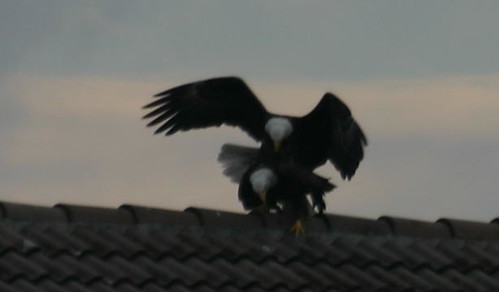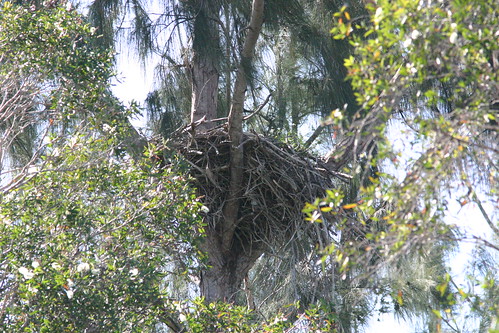Posted by: Ken @ 10:47 am
Good News FLASH! — May 30, 2008
It’s official–
Broward County Now Has Its First Active Bald Eagle Nest of the 21st Century!
I just spoke with Janell Brush, Biologist with Florida Fish and Game Conservation Commission, and was amazed to learn that the nest was discovered in an aerial survey on April 9, 2008, and found to contain one fledgling. Given FWC ID#BO-002, located in Pembroke Pines, 1/4 mile west of US-27 at coordinates N 26.00.44, W 80.25.59 (or N 26.00733, W 80.42650 degrees). It will not appear on the Eagle Locator Map until FWC revises it around mid-June.
Kudos to the pilot (whose name I do not know), who has 30 years of experience finding and monitoring eagle nests…
I am amazed that he saw the nest, as it was flush against the trunk of a live Australian Pine. As you can see from my photo below, it is barely visible from the ground. Apparently, he found the nest cold– no one had reported it at the time!
The last known eagle nest in Broward County was found in 1997, an inactive one in the Miccosukee Reservation, far to the west, near the Collier County line.
Ken
Eagles courting, on the roof of a neighbor’s house, December 4, 2007:

Eagles copulating, December 4, 2007:

Early this past December, I photographed two Bald Eagles courting and copulating at our (South Florida) lake. Within the next 2 weeks they were seen carrying nesting materials to a wooded area near a busy intersection not far away. Despite searching the area, we were not able to find the nest until a neighbor finally located it on April 20. The observer stated: “I didn’t want to linger around and draw attention to the nest but I did notice an eagle flying overhead. It was flying high and it appeared mottled like a juvenile. I really hope this property is not slated for development but I suppose it is only a matter of time.”
This morning I got out and photographed the nest. It is obviously fresh and quite large, about 4 feet in diameter. It is only about 2 miles from our home, and located about two-thirds of the way up in an Australian Pine tree. This is in the same direction as that followed by the eagles that visited our lake, as well as others seen bringing branches and fish from other nearby lakes.
Therefore, it is very likely the nest of “our” pair. The nest site is within sight of a major thoroughfare, about 100 yards from the edge of a 1/8 x 1/4 mile rectangle of drained and formerly cultivated or grazed Everglades, now covered by a relatively undisturbed second-growth forest of Melaleuca & Australian Pine. The first recent record of an eagle nest in Broward County, it is on private land, surrounded on two sides by residential subdivisions, with ever-expanding retail and other commercial development nearby.
Eagle Nest, May 29, 2008:

Updated photo, taken on October 17, 2008, shows the nest to still be in good shape:
The Bald Eagle was removed from protection under the Endangered Species Act in 2007, and was recently taken off Florida’s endangered species list. Last month, a spokesman for the Florida Fish and Wildlife Conservation Commission stated: “The eagles are recovering in Florida with 1,100 active nests counted last year after a low of 88 nests counted in 1973. Monitoring and development restrictions remain in place even after the delisting.”
This is reassuring, but how vigorously will their nest sites be monitored? Eagles tend to re-use prior nesting sites. Given the reduced protection now afforded the species, what can be done to prevent disturbance of this nest? We will keep the location secret, but have notified the Florida Fish and Wildlife Conservation Commission with our concerns. Please do not contact us for this information. Once this nest is entered into the Florida FWCC Nest Locator, you may find it at this Web site:
Florida Fish and Wildlife Conservation Commission Eagle Nest Locator
In order to obtain a better understanding of how protection of the Bald Eagle has been changed, we consulted the FFWCC Bald Eagle Management Plan (PDF Document, Published April, 2008). It truly is interesting reading. Seventy-four pages long, the Plan contains a wealth of information about the breeding biology of Florida’s eagles. It includes a map of all known active eagle nests in Florida, as of 2005-2006. None were recorded as nesting in Broward County. The Plan notes that native pines are favored nesting sites, usually within 1.8 miles of a body of water.
“Most clutches of eggs in Florida are laid between December and early January… with most nests containing two eggs. Incubation lasts about 35 days… Nestlings in Florida fledge at around 11 weeks of age and remain with their parents near the nest for an additional 4 to 11 weeks… Fledglings begin widespread local movements before initial dispersal, which occurs from April to July…”
Eagles have special federal protection in addition to that afforded by the Endangered Species Act:
“…During 2006, the USFWS proposed removing the bald eagle from the list of federally endangered and threatened species, and this action was finalized in August 2007. Although the bald eagle is no longer protected under the Endangered Species Act, it is still protected under theBald and Golden Eagle Protection Act and the Migratory Bird Treaty Act. The USFWS (2007b) has redefined some of the terminology included in the Bald and Golden Eagle Protection Act, which prohibits the unpermitted “take” of bald eagles, including their nests or eggs. The act defines “take” to mean to “pursue, shoot, shoot at, poison, wound, kill, capture, trap, collect, molest or disturb” an eagle. The new definition of “disturb” is to “agitate or bother a bald or golden eagle to the degree that causes, or is likely to cause, based on the best scientific information available, 1) injury to an eagle, 2) a decrease in its productivity, by substantially interfering with normal breeding, feeding, or sheltering behavior, or 3) nest abandonment, by substantially interfering with normal breeding, feeding, or sheltering behavior” (USFWS 2007b). This management plan adopts the federal definition of “disturb” in 50 C.F.R. § 22.3 and Florida’s definition of “take” in Rule 68A-1.004, F.A.C.”
Federal law and regulations protect the nesting habitat of Bald Eagles, irrespective of their status under the Endangered Species Act:
“The USFWS (2007b) Bald Eagle Management Guidelines help the public comply with the Bald and Golden Eagle Protection Act by avoiding activities that disturb bald eagles. These federal guidelines serve as the basis for the FWC Habitat Management Guidelines recommended in this management plan to ensure compliance with Florida wildlife laws concerning bald eagles (see Permitting Framework), and to minimize potentially harmful activities conducted within 660 feet of active or alternate bald eagle nests. In addition, the FWC recommends that nesting habitat be managed as described in the preceding section on habitat management.”
Under the Florida FWCC Plan, there are incentives for private landowners to protect the eagles:
“Private lands play an important role in the long-term conservation of bald eagles in Florida, currently supporting about 67% of all currently known nests. To promote the enhancement of bald eagles and eagle habitats on private lands in Florida, the FWC will:
1. Inform private landowners of existing land-use incentive programs. Incentive programs that can be used to promote conservation of bald eagles are listed in Table 2 (following page). FWC staff will work with owners of private lands who wish to manage their lands for the benefit of bald eagles to determine the most appropriate incentive programs.
2. Inform private landowners of opportunities to sell conservation easements around bald eagle nests on their properties. A developer whose activity is not conducted consistent with the FWC Eagle Management Guidelines (page 23) may elect to purchase a conservation easement around an eagle nest offsite or other suitable bald eagle habitat as a conservation measure. This action will provide another landowner the opportunity to be compensated for permanently conserving a bald eagle nest or nesting habitat.
3. Work with local governments to encourage expedited permit-review and/or reduced development-review fees in exchange for voluntarily following the FWC Eagle Management Guidelines. The FWC recommends that developers who voluntarily avoid potential disturbance of bald eagles by following the FWC Eagle Management Guidelines be granted financial incentives or expedited project review. This recommendation will require the cooperation of local governments.”
The Florida FWCC Plan is now only in PROPOSED form, as its implementation is dependent upon the agency receiving adequate funding to conduct surveys, monitoring and enforcement activities. It will rely on strong cooperation, not only with landowners, but local and county governments, especially during the permitting process. Assuring compliance with these proposed measures will be a daunting task, even though they have become less restrictive over the years. Birders, indeed all citizens, should become familiar with these regulations and track the success of state and local officials in abiding by them. We recommend a full reading of the Plan. Here are a few excerpts.
“The National Bald Eagle Management Guidelines (USFWS 2007b) recommend the establishment of a single buffer zone 660 feet or less from the nest, depending on the presence or absence of existing activities (of “similar scope”) and the visibility of the activity from the nest. The guidelines also recommend minimization measures to reduce the potential for human activities to affect nesting bald eagles. When the bald eagle was listed by the USFWS as threatened, the recommended buffers around bald eagle nests were larger than those now adopted under the National Bald Eagle Management Guidelines (USFWS 2007b). The Southeastern Bald Eagle Habitat Management Guidelines (USFWS 1987) recommended against most activities within 750 feet of an active or alternate bald eagle nest (the primary zone), and added a suite of seasonal recommendations for activities up to 1,500 feet (the secondary zone).
“The USFWS and FWC have approved the installation of infrastructure and external residential/commercial construction within the secondary zone (750–1,500 feet) of bald eagle nests during the nesting season in Florida since the mid-1990s, with the provision that monitoring be conducted to evaluate the response of the eagles to authorized activities. These joint monitoring guidelines were formalized in 2002 to ensure that nest monitoring was conducted consistently, and to serve as a database for evaluating the ongoing and future changes in management recommendations. Results of this monitoring indicate that actions that occurred in the secondary zone were not likely to have a direct negative impact on bald eagles. The Bald Eagle Monitoring Guidelines subsequently were modified on three occasions to obtain data used to evaluate eagles’ response to the revised buffer-zone distances already implemented in Florida and incorporated into the National Bald Eagle Management Guidelines (USFWS 2007b) and to reflect current USFWS policy and regulatory changes in Florida. Initial review of the information in these more recent monitoring reports suggests the current USFWS guidelines are appropriate.
“Some bald eagle pairs in Florida tolerate disturbance much closer than 660 feet from the nest, and the behavior of eagles nesting close to or within developed areas seems to be increasing in Florida. Bald eagle use of urban areas is a relatively new event, and the long-term stability of urban eagle territories has not been documented fully. Although some eagles have demonstrated tolerance for intensive human activity, this does not mean that all eagles will do so (Millsap et al. 2004). A minimum of five years of post-impact data is needed to study the long-term effects of development within regulated nest buffer zones (Nesbitt et al. 1993). Both studies described above (Nesbitt et al. 1993, Millsap et al. 2004) recommended retaining buffer zones around bald eagle nests. Therefore, the conservation of active or alternate bald eagle nests and the retention of recommended buffer zones (USFWS 2007b) are recommended to sustain the bald eagle population in Florida at or above its current level.”
The proposed regulations are followed by a Permitting Framework, dated April 2008.
“To advance the conservation goal and objectives of this management plan, the proposed regulations listed above and this Permitting Framework are intended to assist land-use planning to minimize the potential for certain actions to disturb or “take” nesting bald eagles. This Permitting Framework clarifies (1) those activities that are not likely to result in a “take” or disturbance of bald eagles, and (2) those activities for which permits are available to assure compliance with the rules. A FWC Eagle Permit is not required to conduct any particular activity occurring near a bald eagle nest, but such a permit may be necessary to avoid liability for “take” or disturbance caused by the activity…
“…Unless otherwise specified, this section provides guidelines for activities that occur within 660 feet of any active or alternate bald eagle nest. The framework does not apply to lost or abandoned nests. An active nest shows evidence of breeding by a bald eagle pair during the current or most recent nesting season. An alternate nest has been used for nesting during the past five nesting seasons, but was not used during the current or most recent nesting season. An abandoned nest has not been used for nesting for more than five consecutive nesting seasons. The recommendations in the FWC Eagle Management Guidelines (below) no longer apply to abandoned nests, but the nest itself cannot be altered. A nest is considered lost if the nest tree is destroyed, or if the nest is destroyed by natural causes and is not rebuilt in the same tree within two nesting seasons. The USFWS (2006b) recommends protecting lost nests for three years, but the FWC uses a two-breeding-season period because this duration has been in place in Florida for several years. Future research on nest reactivation may provide information to justify revising these recommended protection periods…”
The Plan includes clear restraints on construction-related activities within 660 Feet of an Eagle Nest. Protection of native pines is encouraged. One concern I have is that it appears that eagles in more developed parts of Florida may, in the absence of native pine trees, adapt to exotic trees such as the Australian Pine, as was the case with “our” bird:
“For projects that receive a FWC Eagle Permit, the following minimization efforts may be required:
2. Avoid construction activity (except those related to emergencies) within 100 feet of an eagle nest during any time of the year except for nests built on artificial structures, or when similar scope may allow construction activities to occur closer than 100 feet.
3. Avoid the use or placement of heavy equipment within 50 feet of the nest tree at any time to avoid potential impacts to the tree roots. This minimization does not apply to existing roads, trails, or other linear facilities near an eagle nest, or to nests built on artificial structures.
4. Schedule construction activities so that construction farther from the nest occurs before construction closer to the nest.
5. Shield new exterior lighting so that lights do not shine directly onto the nest.
6. Create, enhance, or expand the visual vegetative buffer between construction activities and the nest by planting appropriate native pines or hardwoods.
7. Site stormwater ponds no closer than 100 feet from the eagle nest, and construct them outside the nesting season. Consider planting native pines or hardwoods around the pond to create, enhance, or expand the visual buffer.
8. Incorporate industry-approved avian-safe features for all new utility construction
We emphasize our concern that the ability of State officials to monitor and enforce these proposed regulations under the pressure of expanding land development is entirely dependent upon adequate funding, and will require the cooperation of local officials. During the nesting season, even more frequent observations will be necessary:
“The Bald Eagle Monitoring Guidelines (USFWS 2007d) recommend monitoring an eagle nest if construction activities occur within 660 feet of the nest during the nesting season (1 October–15 May). These federal guidelines standardize the method for gathering data to evaluate eagle responses to activities that may cause disturbance. The guidelines are designed to: (1) describe normal nesting behavior of bald eagles; (2) identify specific behavioral responses of adult and young eagles that may warrant cessation of development activities; (3) propose the type and level of monitoring necessary to detect a change in normal eagle behavior; (4) prescribe a procedure for reporting to the USFWS and the FWC the observations that may be used to halt or modify construction activities; and (5) provide data to the FWC to evaluate the effectiveness of the current FWC Eagle Management Guidelines. The FWC has adopted the Bald Eagle Monitoring Guidelines (USFWS 2007d). To ensure compliance with these guidelines, the FWC may conduct random spot-checks of projects that are following the guidelines, as resources allow. The information obtained from these monitoring efforts may provide additional insight into the tolerance of bald eagles to human activities near their nests.”













